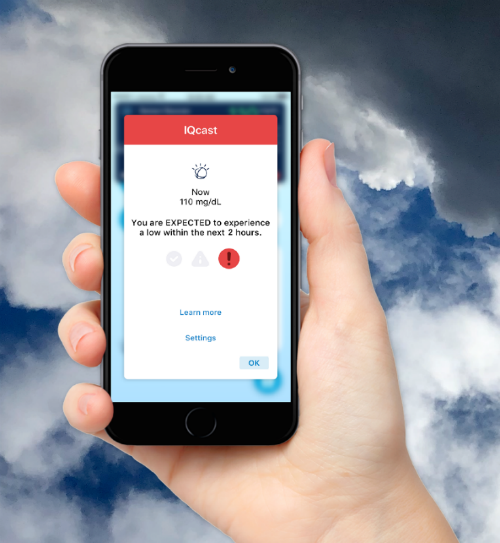AI
Alleviating the Burden of Diabetes with AI
January 3, 2019 | Written by: Lisa Latts, MD
Categorized: AI | Analytics | Watson Health
Share this post:
 How many decisions do you make per day? From the minute you wake up in the morning until you fall asleep that same evening, you likely have to make endless choices: the route you drive to avoid traffic, what you should order for lunch, when to run errands, what type of exercise you want to do at the gym, when to pick up dinner, how much time you should spend walking the dog, just to name a few.
How many decisions do you make per day? From the minute you wake up in the morning until you fall asleep that same evening, you likely have to make endless choices: the route you drive to avoid traffic, what you should order for lunch, when to run errands, what type of exercise you want to do at the gym, when to pick up dinner, how much time you should spend walking the dog, just to name a few.
For people living with diabetes, this situation is even worse. For example, type 1 diabetics face an average of 180 decisions1 each day around how to manage their condition and keep blood sugar levels in check. Every meal, snack, and insulin injection must be carefully thought through and accounted for – no matter what other decisions they’re also juggling. Errors or a lack of attention can lead to a dangerous condition called hypoglycemia, in which blood sugar levels drop to unsustainable lows and cause anxiety, dizziness, weakness and fainting. Adding to these daily challenges can be other long-term complications, which compounds the burden of time, emotions and energy that must be endured.
Hypoglycemia, or “going low,” is one of the most acute, debilitating and frightening events that a person living with diabetes can experience. It is a serious event that can cause severe problems or even death if left untreated, and it can leave an individual incapacitated up to hours at a time. Its remedy is often consuming glucose or sugar to bring up blood sugar levels, making it very easy to overcorrect sugar levels and go into a dangerous pattern of highs and lows.
Watch this video: The Deal with Lows
Fueled by the right data, AI and analytic tools can play a powerful role in helping to alleviate the burden of diabetes management. In partnership with leading healthcare and research organizations, IBM is applying technology to help find a solution to this challenge.
IBM Watson Health and Medtronic Launch IQCast Feature to Help Predict Blood Sugar Events
Together with Medtronic, we have built and launched the IQcast predictive feature within Medtronic’s Sugar.IQ diabetes assistant app. We launched Sugar.IQ with Medtronic in June to transform how people living with diabetes interact with continuous glucose monitors. Powered by machine learning and pattern-recognition algorithms in a HIPAA-enabled environment, Sugar.IQ analyzes blood glucose levels, insulin data, hypoglycemia episodes and food logs to give personalized insights and uncover important trends that can impact an individual’s glucose levels.
Sugar.IQ’s newest feature, IQcast, is built on AI and machine learning models that analyze multiple signals to assess when someone with diabetes has a low, medium or high risk of experiencing a hypoglycemic event within an upcoming 1-4 hour window. The degree of predictive accuracy that IQcast is able to achieve increases as a low blood sugar event becomes more imminent.(3)
To Sugar.IQ users, this forecast may make all the difference. Instead of guessing if hypoglycemia may occur – or worse, not knowing – they have the resources to learn more about their patterns and take proactive steps to help prevent it from happening, whether that’s eating a snack, timing their meals better, or adjusting their insulin dose.
These types of insights can be extremely powerful. As presented at the American Diabetes Association Scientific Sessions (2017, 2018), when using both the Guardian Connect smart CGM system in conjunction with the Sugar.IQ app, users have shown the ability to achieve in extra 36 minutes per day in a healthy glucose range of 70-180 mg/dL, including 30 minutes less time in hyperglycemia and 6 less minutes in hypoglycemia.(4)
Applying AI to Improve Diabetes Care and Prevent Complications
In addition to the burden of managing their condition, people living with diabetes often find their situation is compounded by complications.
Within IBM Watson Health, we are also examining how AI can help clinicians to as they strive to improve a broad spectrum of diabetes care, costs and outcomes for their patients. For example, Watson Health researchers published a new study2 with findings from a review of 450 published studies, which examined the various uses of AI in the treatment of Type 2 diabetes. Our analysis showed four key areas of diabetes care hold the most potential to be transformed by technology: predictive population risk stratification, clinical decision support, retinal screening and patient self-managed tools.
Already, our researchers are working within one of these areas, and have published research which shows how machine learning and AI can be applied to medical data to help predict and identify individuals who are at risk for multiple complications after being diagnosed with type 2 diabetes.
Collaborating with Academics and Nonprofits to Explore Diabetes Predictions and Risks
Hopefully, one day we will understand enough about diabetes so that we can comprehend how to predict and prevent its onset and risks.
In collaboration with JDRF, the leading global organization funding type 1 diabetes (T1D) research, we are undertaking research that could one day help physicians predict the onset of type 1 diabetes. This builds on top of work we announced a year ago that brings machine learning to years of independent type 1 diabetes research data, with the goal of identifying clues that can indicate the onset of the disease.
Additionally, we are also working with the Academy of Nutrition and Dietetics to analyze the impact of real-world dietitian interventions and their outcomes on diabetes, pre-diabetes and obesity.
We’re also teaming with top academic institutions to advance the science and application of AI to healthcare. Through the AI Horizons Network, IBM and Rensselaer Polytechnic Institute (RPI) established the Center for Health Empowerment by Analytics, Learning and Semantics (HEALS). As a part of our work together, we’re aiming to support physicians in treating complex cases of Type 2 diabetes by making clinical guidelines more transparent, and in turn easier to apply to specific cases and treatments.
Of course, technology alone cannot alleviate the burden of managing diabetes. As we continue to work with our partners to find greater ways in which technology can help clinicians and those living with diabetes to manage their condition, we are confident that the ultimate best solution will be one in which patient engagement, professional care, technology, data and informatics all come together to optimize treatment.
_____________________________________
- http://scopeblog.stanford.edu/2014/05/08/new-research-keeps-diabetics-safer-during-sleep/
- https://www.liebertpub.com/doi/10.1089/pop.2018.0129
- Low Blood Sugar or Hypoglycemia is defined as a blood sugar less than 70. Please note that this is level 1 hypoglycemia as defined by the American Diabetes Association (http://www.diabetes.org/newsroom/press-releases/2016/ada-issues-hypoglycemia-position-statement.html). High Blood Sugar or Hyperglycemia is defined as a blood sugar above 180.
- Clinical findings presented at the 2017 and 2018 American Diabetes Association 78th Scientific Sessions (2018: https://plan.core-apps.com/tristar_ada18/abstract/807d2f9885450670bb994661e35f8126; 2017: http://www.abstractsonline.com/pp8/#!/4297/presentation/45397)

Deputy Chief Health Officer, IBM
How Data and Analytics Can Power a Transformation in Long-Term Disability
Employer-provided disability insurance has a problem — it’s reactive, risk-based payout, and in its current state, it cannot affect the metrics employers and employees truly care about: employee engagement, productivity and wellness. Modern disability insurance first became available in the late 19th century and was called “accident insurance.” It was meant to protect workers in […]
Saying ‘Yes’ to Business Process Automation
Despite popular belief, technological progress has always been supported and enhanced by the collaboration between humans and machines working together. Digitalization is not only about transferring data into an electronic form, but also about using these forms and finding new ways of developing them. Innovation in technology helps us to come up with new ideas, […]
New-School Analytics: Knowing Your Customers’ Communities
Personalization drives nearly every marketing and sales initiative nowadays. Businesses try to duplicate in the digital realm the face-to-face interactions that small-town grocers have with their customers. Advanced data collection and analytics help fill the void of actual conversation to make sense of all kinds of customer information: historical data from past purchases, behavioral data […]


